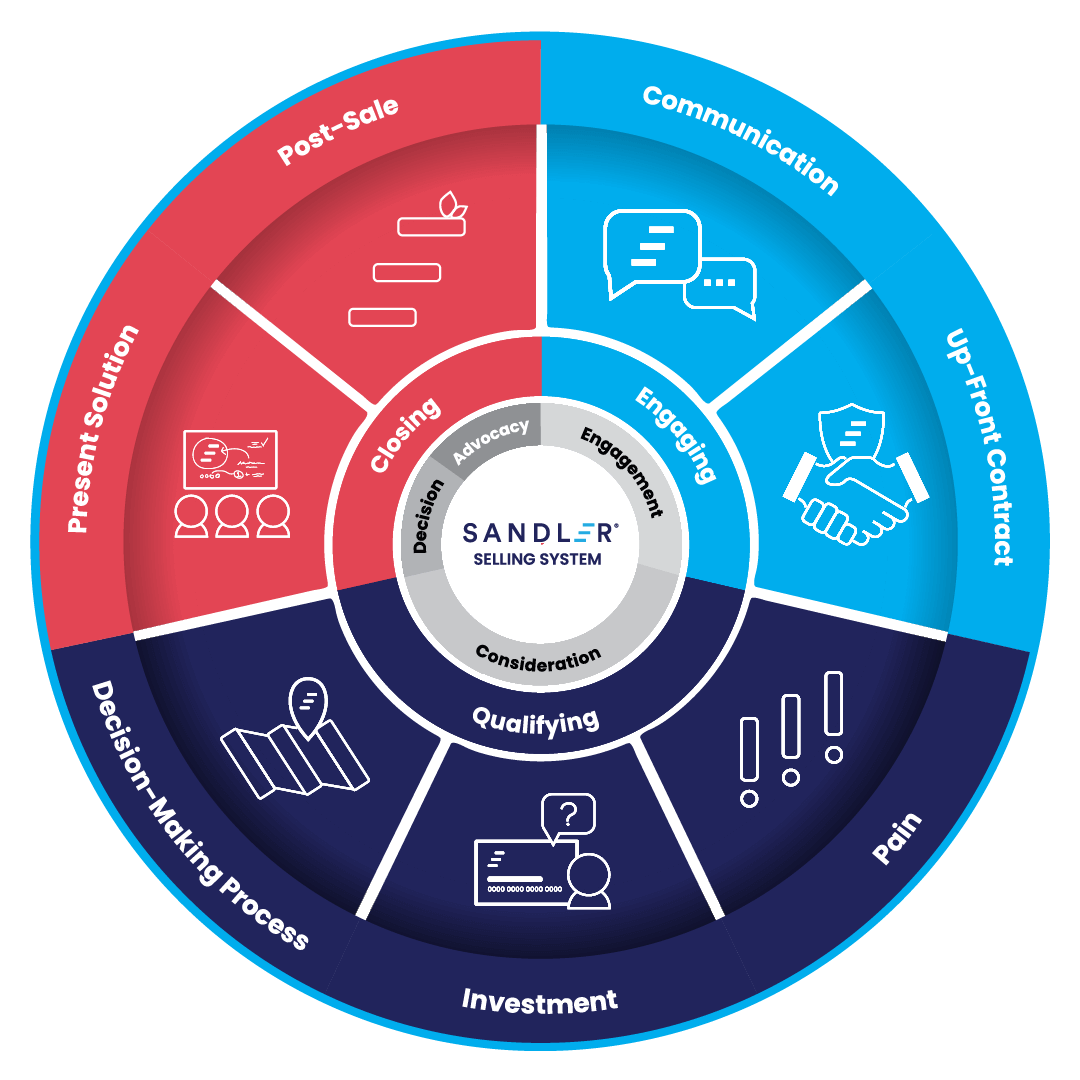Sales Leaders: Do You Live the Process?
David Sandler, the founder of our company, patterned his selling system as a tool for both sales and leadership. In fact, his system is where the disciplines of sales and leadership converge.
Effective sales leaders don’t just understand Sandler’s seven-step process; they model it for their team, and live it as a daily working reality. They understand that each step of the system must be in the proper order for the buyer and the seller to move through the sales process together. They also realize that the seller’s relationship with the buyer operates in parallel with the sales leader’s relationship with the members of the sales team.
The steps of the Sandler Selling System are:
- Bonding & Rapport: Building a relationship by developing a way to communicate effectively with people and building trust.
- Up-Front Contracts: Getting on the same page as the other person by setting expectations and insuring a clear outcome to each step in the process.
- Pain: Discovering the emotional reason for people to take action to change the status quo.
- Budget: Determining what resources people are willing and able to invest to solve the problem – and make their pain go away.
- Decision: Identifying what must happen, and with whom, in order for an action plan for removing the pain to move forward.
- Presentation/Fulfilment: Matching solutions to each pain uncovered during the discovery process. Sandler emphasized “fulfillment” because he knows that effective leaders only present recommendations that fulfill their commitment to being a collaborative partner in the problem-solving process.
- Post-Sell: Dealing with “buyer’s remorse” ahead of time, blocking outsiders from reopening a decision that has been made -- and securing key referrals and introductions.
 Successful salespeople consistently follow these seven steps in this specific sequence; Outstanding sales leaders also adhere to the steps in the same order. In other words, it's both a sales process and a leadership process. It encompasses both strategies and tactics because it is a behavioral process map.
Successful salespeople consistently follow these seven steps in this specific sequence; Outstanding sales leaders also adhere to the steps in the same order. In other words, it's both a sales process and a leadership process. It encompasses both strategies and tactics because it is a behavioral process map.
Specific behaviors are behaviors associated with each step of the process. Those behaviors, when executed, equal results. Many managers just look at the results. They don’t look at the behavior that produces the results. The Sandler system helps you avoid that problem—but only if it becomes part of your sales team’s culture and part of your daily leadership style.
Sandler methodologies can become part of your team’s DNA. They guide your team as they talk to prospects and customers—and they guide you as you interact with the members of your team.
These powerful methodologies—setting goals, creating a roadmap to get you where you want to be, monitoring your own behaviors and comparing them to daily targets, knowing it’s OK to close the file, knowing that role-play makes you strong, being accountable to yourself and others—aren’t effective when they’re just slogans. They aren’t effective when they’re just words you repeat or posters you hang up on the wall.
They are effective when internalized and become relationships, how you conduct business and support relationships, and become part of your day after day. These methodologies are effective when they determine, daily, how you live your life as a sales leader.
So, one big question is: How do you make this system part of your team’s DNA? That’s not something that happens as the result of a single memo or a single meeting. It happens when you model the system personally. Here are some action items to consider that support that kind of modeling.
- Does your team’s sales process align with the steps of the Sandler Selling System? For instance: Do your people discuss budget before they present? How do you know?
- Are all of your team members selling according to that sales process? If you asked each member of the team to describe your sales process, would they all describe it accurately?
- Is your sales process part of your onboarding program? Does each new hire should know your process well enough to be able to explain it accurately? Has each new hire been given the resources necessary to lock in and use that knowledge.
- Are the steps of your sales process visible in graphic form, and ubiquitous? Do your people see it every day?
- Are the steps of your sales process reflected in your CRM tool? Is it clear what must happen, and how it must happen, for an opportunity to move from one step or sub-step of your process to the next? Does each step or sub-step move the CRM’s close rate forward?
- Do you use your sales process as the basis of your debriefings with salespeople. Do you ask what happened and what’s next based on the steps of the sales process, and on which part of the sales process needs to be completed next?
- Does your one-on-one coaching align with your sales process? When leaders reinforce the sales process during coaching sessions, it becomes part of the team culture.
- Do you use the language of the system daily? For instance: “What was your Up-Front Contract with this buyer?”
The key takeaway: The Sandler Selling System is a behavioral process map. And this map is not just something salespeople can turn to for guidance. It’s for you, too. In fact, it’s for you first! Explore how the Sandler Selling System can transform your team's performance and culture. Contact us today to start making it part of your DNA.



